Genre: Platformer Developer: BlueSky Software Publisher: Sega Enterprises Players: 1 Released: 1995
Desert Demolition is one of those Genesis platformers that seem to go under the radar due to its release date. It’s a shame too because it’s a very good game. It’s a platforming game developed by Blue Sky and Sega Enterprises in 1995 and is one of the few Genesis games actually NOT released in Japan. It stars the famous Looney Toons duo Wile E. Coyote and Road Runner as they race through each level, with one chasing the other around in the exact same vein as their cartoons.
You have two options in terms of gameplay, which is actually different and unique for a platformer: You can play as Wile E. Coyote and use different ACME gadgets to try and catch Road Runner, or you can play as Road Runner and run at top speeds through the level dodging Wile E. Coyote. You have a certain amount of lives, and a time limit to get through each level. Losing all your health from taking damage causes you to start from the beginning of the level and losing all your lives means game over. Running out of time also causes you to lose a life.
The gameplay is very unique though for a platformer. It’s not your standard “run-n-jump” game, rather it focuses on how fast you can go and how many points you can get through collecting stamps and doing objectives as stated by the starting screen. Instead of jumping and walking, you run and leap around. There are also some special gameplay additions such as lighting TNT piles under rocks to boost you up, getting shot up by geysers, and the ACME devices. Damage in the game is also unique as well. You have a damage meter, and it decreases after running too fast into a wall, or smashing into the ground after a long jump, or hitting your head on a low or spiked ceiling. The damage taken in this game is really spot-on in terms of emulating scenes from the cartoons, and most of it is set up when you are playing as Wile E. It’s pure cartoon madness!
When playing as Wile E. Coyote, you run around the levels and/or use different ACME brand gadgets to try and catch Road Runner. The ACME devices are found in ACME boxes that you jump into. These boxes give you a special power-up that lasts for a minute or two, and they vary from flying suits to spring shoes. You go through each level collecting stamps and trying to catch Road Runner while he’s either trapped or distracted by the small piles of bird seed lain around the levels.
When playing as Road Runner, you have to simply collect stamps and run away from Wile E. Coyote to the end of the level within the time limit. You can eat bird seed piles on the ground for extra points, which is obviously the parallel to Wile E. catching Road Runner for points. The gameplay of the game may sound rather easy, but it’s actually very different, and takes some time to get used to. It gives the game somewhat of a learning curve, but it helps the game to be more unique and less of the same old, same old for each level.
There are six levels in Desert Demolition. They’re made to look the same for each player, but they are actually set up differently gameplay-wise depending on who you are playing as. With this practice, the levels actually become rather diverse, creating two modes of single-player gameplay. The different levels include going through deserts, mines, canyons, and even moving trains. Each stage is split up into two parts, but the game is still rather short overall. The game is actually rather challenging in a good way for a platformer though, and since both Wile E. and Road Runner play differently, it doubles, possibly even triples the gameplay time. This makes the small amount of levels not as big of a problem. There are also bonus levels added into the game that are completely different between Road Runner and Wile E.
The graphics and sounds are delightful, and they recreate the show’s premise spot on. The characters and backgrounds are clear and make it seem as if you’re actually watching the cartoon. Backgrounds scroll fast when you run, and the screen shakes when you take damage. The sound effects are very cartoon-like, from springs, to explosions, to bells clanging when you run right into a wall. The music of the game is very interesting and seems like the very nature of it was pulled right out of the cartoon. For example, when you walk music starts up, and when you stop walking, the music stops. When you run, fast drum beats play. There’s also different music for the ACME items as well. The whole music when moving around basically accounts for the background music of this game, and when you are jumping for stamps, sometimes the game will start to get quiet for long periods of time. The music also stops abruptly when you take damage. This is kind of annoying for some, but it does help recreate the whole cartoon scene. The whole way the music is designed to play is very faithful to the cartoon.
In conclusion, Desert Demolition is a very entertaining game. It makes you feel as if you’re controlling a Wile. E Coyote and Road Runner cartoon with your Genesis. If you see this game, pick it up. You’ll get a decent amount of fun out of it, especially if you’re a Looney Toons fan. It’s not a very linear platforming game, but that’s what makes it stand out from some of the other Sega platformers that aren’t Sonic or Mickey Mouse/Donald Duck. Its late release causes it to be overshadowed though by those popular Sega franchises, which allows you to find the game for a relatively cheap price. And the fact that it was released late in the Genesis’ lifespan gives it some more graphical and sound prowess compared to earlier Genesis games.
SCORE: 8 out of 10

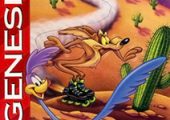
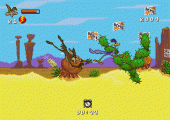
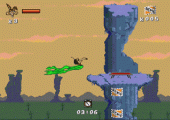
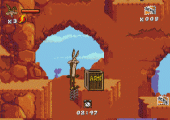
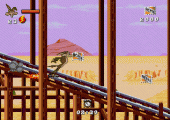
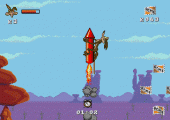
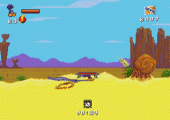
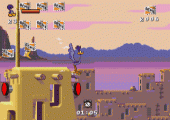
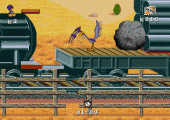
I wish that this game included a two-player mode – it could have been all of the fun of dashin desperadoes with a looney tunes flair.